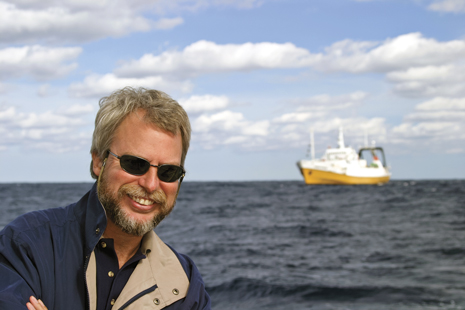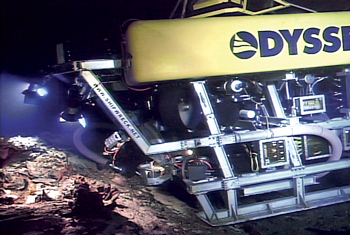Innovative thinkers
Greg Stemm: Acoustics, ROVs and deep-sea shipwrecks
|
Greg Stemm
Epitomized by movies, such as 1985’s “Goonies” and the “Pirates of the Caribbean” trilogy, shipwreck exploration is by no means a new concept. Finding treasures three miles deep, however, is unique. Greg Stemm, co-founder and CEO of Odyssey Marine Exploration, has lived the dream of deep-sea shipwreck exploration for over 25 years. From leading the world’s first complete, remote, robotic archaeological excavation using integrated acoustic positioning, to mapping out over 17,000 sq mi of seabed, Stemm is in the pursuit of treasure—and the chance to bring history back to life. After attending the New College of Florida, Stemm co-founded Seahawk Deep Ocean Technology in 1986 and worked there until January 1994, while serving as a founding director of the Young Entrepreneurs Organization. “I took an interest in exploring the ocean at a very young age, when I read National Geographic magazine, watched Jacques Cousteau TV specials and consumed anything I could get my hands on about ocean exploration.” Stemm said. “I was also a fishing fanatic and remember bottom-fishing in the Gulf of Mexico, trying to imagine what was lying on the bottom.” In 1986, Stemm and business partner John Morris decided to make their dream happen: they began acquiring technology to explore the deep ocean. They purchased their first research vessel and remotely operated vehicle (ROV) system, which they were introduced to by Graham Hawkes and Sylvia Earle, both pioneers in ocean exploration and owners of Deep Ocean Engineering. “Graham was building some amazing new technologies for working remotely in the deep ocean, and we had a number of customized systems built for us. We also bought several different types of acoustic search systems, starting with the old dry paper side-scan sonars, and pushing the limits of digital technology back then,” Stemm recalled. “I remember that when we first put side-scan data on TV screens, we would also record paper backups, because no one trusted the newly emerging digital recording technology.” They next brought onboard a skilled team of experts from the oil-and-gas and telecommunications industries. The duo got to work in applying the technologies that they had worked with in previous ocean exploration, as well as new methods for detecting vessels on the seabed. There were rapid advances during the 1980s as the offshore oil and gas industry evolved, then when oil prices dropped precipitously during the 1990s a lot of the deep water R&D money was put on hold. Stemm and Morris’ first success came in 1987, when Oceaneering had been hired by an insurance company to locate a lost ship off Florida’s east coast. “They were not able to find it, but we did, using our new side-scan and Phantom ROV,” Stemm said. Two years later, Stemm and Morris discovered an old shipwreck off the Florida Keys, in 1,500 ft of water. The wreck was likely the remains of the 117-ton Buen Jesus Nuestra Senor de Rosario, one of the vessels bound for Spain in 1622. “We had this crazy idea that you could conduct a complete archaeological excavation using a robotic vehicle, and spent nearly a year comparing notes with archaeologists and offshore oilfield technicians that we utilized to design the system, which we christened ‘Merlin’,” Stemm said. From ancient shipwreck sites dating back to 300 BC, to warships and cargo vessels, the team saw a huge opportunity to be able to go into deeper and deeper waters, which held history’s most hidden secrets. Along with the 251-ft dynamically positioned Odyssey Explorer, and two 8-ton ROVs named ZEUS I and ZEUS II, Stemm and his team, which consists of archaeologists, ROV pilots, data loggers, conservators and project managers, had the capability of reaching depths of up to 8,200 ft, the deepest waters ever to be searched for shipwrecks. Dubbed as the eyes and hands of the operation, both ROVs have high-powered HMI lights to illuminate pitch-black shipwreck sites and create high-definition photos and video. All data acquired by the ROVs are processed and sent to the surface in real time, where technicians use the photos and video to create a virtual model, or photomosaic, of the seabed and any areas of interests, such as vessel wreckage. Once a site has been identified, the ROVs are sent down to the sea floor with acoustic transponders, which are implanted around the site, to transmit acoustic signals. The sound waves are bounced between the wreck, transponders and data points, and the site is recorded as a grid of 1.0 sq m. Specialists create a 3D layer onto the photomosaics. In addition to surveying and excavating wreck sites, Odyssey also works with scientists and biological experts regarding the unique marine species that live around the sites. “We have always ridden a step behind the bleeding edge of the development and funding of this technology by the oil and gas, military and academic sectors. For the past decade, we have seen developments of advanced digital technology, advanced synthetic ropes, more dependable remote systems and fiberoptic telemetry funded by billions of dollars in development costs for deep-ocean oil and gas,” Stemm said. “The recovery of silver from the Gairsoppa by our offshore team at a depth of 4,700 m is an example of application of these new advanced technologies to our field.” Stemm’s combination of unique technology, specialized staff and relentless determination to make the next big find has yielded some impressive results, to say the least. In 2003, Odyssey Marine Exploration made its first big find find—the long-lost SS Republic, which sank off the coast of Georgia during a hurricane in 1965. Over 51,000 coins and 14,000 artifacts, worth an estimated $75 million, were recovered. During the exploration and excavation of the SS Republic, ZEUS completed 262 dives on the wreck site and logged almost 3,500 hr, including one uninterrupted 72.7-hr dive. “During the course of 14 months of excavation of that site, we perfected many of the techniques we use today on both shipwrecks and for mineral exploration,” said Stemm. Just four years later, Stemm and his team made another groundbreaking find – the discovery of over 500,000 gold and silver coins in the deepwater at a site they code-named “Black Swan”. One hypothesis is that the cargo could have originated from the Spanish vessel Nuestra Señora de las Mercedes, which was sunk by the British navy off the coast of Portugal in 1804.
The team utilized almost 15,000 high-resolution images to virtually map out the site, then used Zeus to survey and excavate the area. Dubbed the largest collection of coins to be recovered from a deep ocean site, Spain staked its claim to the treasure, claiming that since the sunken vessel was a Spanish warship, its contents belonged to the country, even though historical records showed that 72% of the coins aboard the Mercedes were owned by private merchants. Nevertheless, U.S. courts ruled in Spain’s favor, and the coins were released to Spain’s custody in 2012. This was the first time, ever, that a court without jurisdiction ordered disposition of property to a third-party claimant. “It’s a dramatic business,” Stemm told Businessweek in June 2012. “We’ve spent more on wrecks we haven’t found than the $2.6 million we spent on the Black Swan.” While Odyssey has invested $123 million in acquiring technology over the last 15 years, the company seems to have recently hit a lucky streak. Over the last four years, Odyssey has made several historic finds, including the HMS Victory and the SS Gairsoppa, which reportedly was carrying seven million ounces of silver when it sank in 1941. In July 2012, Odyssey announced that it had recovered around 48 tons of silver bullion from the SS Gairsoppa. The ship’s final resting place was more than three miles underwater, and the operation has become the heaviest and deepest recovery of precious metals in history. Odyssey is conducting the Gairsoppa project under contract with the UK Department for Transport, bearing the risk of search and recovery, and retaining 80% of the net salvaged value of the silver cargo after recovering its expenses. Recovery operations are expected throughout the fall. As of today, Odyssey has surveyed and mapped more than 17,000 sq mi of seabed and spent more than 10,000 hours diving on shipwreck sites. Odyssey is also employing a variety of techniques used by the oil and gas industry in its quest to search deeper and deeper. “Side-scan sonars and ROVs are used in both oil and gas, as well as deep-ocean exploration,” said Stemm. “We have adapted many other technologies for archaeological and exploration operations, including long baseline acoustic systems, inertial navigation, advanced manipulators, and RV control and telemetry systems.” Despite the financial ups-and-downs and risks that come with the exploration and excavation of shipwrecks, Stemm is determined to keep searching. “We are working on combining layers of acoustic, photographic, and other geophysical and geo technical data, which can be used to either locate different types of materials in the sediment on shipwreck sites, or to find and analyze deep-ocean mineral resources,” said Stemm. “We have also pushed the limits of advanced photomosaics, developing geospatially accurate images of large areas of the sea bottom, in one case using this technique to document an airplane crash site the size of six football fields with a photomosaic that allowed you to see and determine the position of an item as small as a quarter… Our future has never looked better.”
|
- Prices and governmental policies combine to stymie Canadian upstream growth (February 2024)
- U.S. producing gas wells increase despite low prices (February 2024)
- U.S. drilling: More of the same expected (February 2024)
- U.S. oil and natural gas production hits record highs (February 2024)
- X80 heavy wall pipe solutions for deep/ultra-deepwater field developments in mild sour environment (November 2023)
- Wellbore seal control and monitoring enhance deepwater MPD operations (October 2023)




